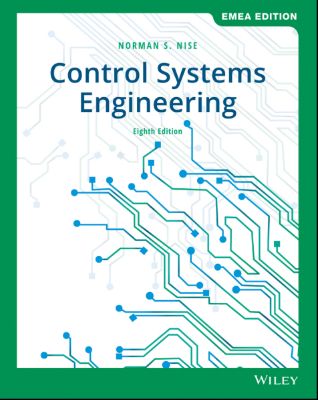
Lýsing:
Highly regarded for its accessibility and focus on practical applications, Control Systems Engineering offers students a comprehensive introduction to the design and analysis of feedback systems that support modern technology. Going beyond theory and abstract mathematics to translate key concepts into physical control systems design, this text presents real-world case studies, challenging chapter questions, and detailed explanations with an emphasis on computer aided design.
Abundant illustrations facilitate comprehension, with over 800 photos, diagrams, graphs, and tables designed to help students visualize complex concepts. Multiple experiment formats demonstrate essential principles through hypothetical scenarios, simulations, and interactive virtual models, while Cyber Exploration Laboratory Experiments allow students to interface with actual hardware through National Instruments’ myDAQ for real-world systems testing.
Annað
- Höfundur: Norman S. Nise
- Útgáfa:8
- Útgáfudagur: 01/2020
- Hægt að prenta út 10 bls.
- Hægt að afrita 2 bls.
- Format:ePub
- ISBN 13: 9781119636342
- Print ISBN: 9781119590132
- ISBN 10: 1119636345
Efnisyfirlit
- Cover
- Preface
- Key Features
- New to This Edition
- Ancillary Material
- Book Organization by Chapter
- Acknowledgments
- Chapter 1: Introduction
- Chapter 1 Problems
- Progressive Analysis and Design Problems
- Readings
- 1.1 Introduction
- 1.2 A History of Control Systems
- 1.3 System Configurations
- 1.4 Analysis and Design Objectives
- 1.5 The Design Process
- 1.6 Computer-Aided Design
- 1.7 The Control Systems Engineer
- Summary
- Review Questions
- Cyber Exploration Laboratory
- Bibliography
- Chapter 1 Problems
- Chapter 2 Problems
- Progressive Analysis and Design Problems
- Readings
- 2.1 Introduction
- 2.2 Laplace Transform Review
- 2.3 The Transfer Function
- 2.4 Electrical Network Transfer Functions
- 2.5 Translational Mechanical System Transfer Functions
- 2.6 Rotational Mechanical System Transfer Functions
- 2.7 Transfer Functions for Systems with Gears
- 2.8 Electromechanical System Transfer Functions
- 2.9 Electric Circuit Analogs
- 2.10 Nonlinearities
- 2.11 Linearization
- Summary
- Review Questions
- Cyber Exploration Laboratory
- Bibliography
- Chapter 3 Problems
- Progressive Analysis and Design Problems
- Readings
- 3.1 Introduction
- 3.2 Some Observations
- 3.3 The General State-Space Representation
- 3.4 Applying the State-Space Representation
- 3.5 Converting a Transfer Function to State Space
- 3.6 Converting from State Space to a Transfer Function
- 3.7 Linearization
- Summary
- Review Questions
- Cyber Exploration Laboratory
- Bibliography
- Chapter 4 Problems
- Design Problems
- Progressive Analysis and Design Problems
- Readings
- 4.1 Introduction
- 4.2 Poles, Zeros, and System Response
- 4.3 First-Order Systems
- 4.4 Second-Order Systems: Introduction
- 4.5 The General Second-Order System
- 4.6 Underdamped Second-Order Systems
- 4.7 System Response with Additional Poles
- 4.8 System Response with Zeros
- 4.9 Effects of Nonlinearities upon Time Response
- 4.10 Laplace Transform Solution of State Equations
- 4.11 Time Domain Solution of State Equations
- Summary
- Review Questions
- Cyber Exploration Laboratory
- Bibliography
- Chapter 5 Problems
- Design Problems
- Progressive Analysis and Design Problems
- Readings
- 5.1 Introduction
- 5.2 Block Diagrams
- 5.3 Analysis and Design of Feedback Systems
- 5.4 Signal-Flow Graphs
- 5.5 Mason's Rule
- 5.6 Signal-Flow Graphs of State Equations
- 5.7 Alternative Representations in State Space
- 5.8 Similarity Transformations
- Summary
- Review Questions
- Cyber Exploration Laboratory
- Bibliography
- Chapter 6 Problems
- Design Problems
- Progressive Analysis and Design Problems
- Readings
- 6.1 Introduction
- 6.2 Routh–Hurwitz Criterion
- 6.3 Routh–Hurwitz Criterion: Special Cases
- 6.4 Routh–Hurwitz Criterion: Additional Examples
- 6.5 Stability in State Space
- Summary
- Review Questions
- Cyber Exploration Laboratory
- Bibliography
- Chapter 7 Problems
- Design Problems
- Progressive Analysis and Design Problems
- Readings
- 7.1 Introduction
- 7.2 Steady-State Error for Unity-Feedback Systems
- 7.3 Static Error Constants and System Type
- 7.4 Steady-State Error Specifications
- 7.5 Steady-State Error for Disturbances
- 7.6 Steady-State Error for Nonunity-Feedback Systems
- 7.7 Sensitivity
- 7.8 Steady-State Error for Systems in State Space
- Summary
- Review Questions
- Cyber Exploration Laboratory
- Bibliography
- Chapter 8 Problems
- Design Problems
- Progressive Analysis and Design Problems
- Readings
- 8.1 Introduction
- 8.2 Defining the Root Locus
- 8.3 Properties of the Root Locus
- 8.4 Sketching the Root Locus
- 8.5 Refining the Sketch
- 8.6 An Example
- 8.7 Transient Response Design via Gain Adjustment
- 8.8 Generalized Root Locus
- 8.9 Root Locus for Positive-Feedback Systems
- 8.10 Pole Sensitivity
- Summary
- Review Questions
- Cyber Exploration Laboratory
- Bibliography
- Chapter 9 Problems
- Design Problems
- Progressive Analysis and Design Problems
- Readings
- 9.1 Introduction
- 9.2 Improving Steady-State Error via Cascade Compensation
- 9.3 Improving Transient Response via Cascade Compensation
- 9.4 Improving Steady-State Error and Transient Response
- 9.5 Feedback Compensation
- 9.6 Physical Realization of Compensation
- Summary
- Review Questions
- Cyber Exploration Laboratory
- Bibliography
- Chapter 10 Problems
- Progressive Analysis and Design Problems
- Readings
- 10.1 Introduction
- 10.2 Asymptotic Approximations: Bode Plots
- 10.3 Introduction to the Nyquist Criterion
- 10.4 Sketching the Nyquist Diagram
- 10.5 Stability via the Nyquist Diagram
- 10.6 Gain Margin and Phase Margin via the Nyquist Diagram
- 10.7 Stability, Gain Margin, and Phase Margin via Bode Plots
- 10.8 Relation Between Closed-Loop Transient and Closed-Loop Frequency Responses
- 10.9 Relation Between Closed- and Open-Loop Frequency Responses
- 10.10 Relation Between Closed-Loop Transient and Open-Loop Frequency Responses
- 10.11 Steady-State Error Characteristics from Frequency Response
- 10.12 Systems with Time Delay
- 10.13 Obtaining Transfer Functions Experimentally
- Summary
- Review Questions
- Cyber Exploration Laboratory
- Bibliography
- Chapter 11 Problems
- Design Problems
- Progressive Analysis and Design Problems
- Readings
- 11.1 Introduction
- 11.2 Transient Response via Gain Adjustment
- 11.3 Lag Compensation
- 11.4 Lead Compensation
- 11.5 Lag-Lead Compensation
- Summary
- Review Questions
- Cyber Exploration Laboratory
- Bibliography
- Chapter 12 Problems
- Design Problems
- Progressive Analysis and Design Problems
- Readings
- 12.1 Introduction
- 12.2 Controller Design
- 12.3 Controllability
- 12.4 Alternative Approaches to Controller Design
- 12.5 Observer Design
- 12.6 Observability
- 12.7 Alternative Approaches to Observer Design
- 12.8 Steady-State Error Design via Integral Control
- Summary
- Review Questions
- Cyber Exploration Laboratory
- Bibliography
- Chapter 13 Problems
- Design Problems
- Progressive Analysis and Design Problems
- Readings
- 13.1 Introduction
- 13.2 Modeling the Digital Computer
- 13.3 The z -Transform
- 13.4 Transfer Functions
- 13.5 Block Diagram Reduction
- 13.6 Stability
- 13.7 Steady-State Errors
- 13.8 Transient Response on the z-Plane
- 13.9 Gain Design on the z-Plane
- 13.10 Cascade Compensation via the s-Plane
- 13.11 Implementing the Digital Compensator
- Summary
- Review Questions
- Bibliography
- Layout
- Schematic
- Block Diagram
- Schematic Parameters
- Block Diagram Parameters
- Pitch Control System
- Heading Control System
- B.1 Introduction
- B.2 MATLAB Examples
- B.3 Command Summary
- Bibliography
- C.1 Introduction
- C.2 Using Simulink
- C.3 Examples
- C.4 Using Simulink for Control System Design
- Summary
- Bibliography
- D.1 Introduction
- D.2 Control Systems Analysis, Design, and Simulation
- D.3 Using LabVIEW
- D.4 Analysis and Design Examples
- D.5 Simulation Examples
- D.6 Interfacing with External Hardware
- Summary
- Bibliography
- E.1 Introduction
- E.2 The Linear System Analyzer: Description
- E.3 Using the Linear System Analyzer
- E.4 Linear System Analyzer Examples
- E.5 Simulink and the Linear Analysis Tool
- E.6 Using the Linear Analysis Tool with Simulink to Analyze a Response
- E.7 The Control System Designer: Description
- E.8 Using the Control System Designer
- Summary
- Bibliography
- F.1 Introduction
- F.2 Symbolic Math Toolbox Examples
- F.3 Command Summary
- Bibliography
- G.1 Matrix Definitions and Notations
- G.2 Matrix Operations
- G.3 Matrix and Determinant Identities
- G.4 Systems of Equations
- Bibliography
- H.1 Step Response of a System Represented in State Space
- H.2 Root Locus and Frequency Response
- Bibliography
- J.1 Derivation
- Bibliography
- Bibliography
- L.1 Introduction
- L.2 Expressing Any Vector in Terms of Basis Vectors
- L.3 Vector Transformations
- L.4 Finding the Transformation Matrix, P
- L.5 Transforming the State Equations
- Bibliography
- M.1 Derivation of the Behavior of the Root Locus at Infinity (Kuo, 1987)
- M.2 Derivation of Transition Method for Breakaway and Break‐in Points
- Bibliography
UM RAFBÆKUR Á HEIMKAUP.IS
Bókahillan þín er þitt svæði og þar eru bækurnar þínar geymdar. Þú kemst í bókahilluna þína hvar og hvenær sem er í tölvu eða snjalltæki. Einfalt og þægilegt!Rafbók til eignar
Rafbók til eignar þarf að hlaða niður á þau tæki sem þú vilt nota innan eins árs frá því bókin er keypt.
Þú kemst í bækurnar hvar sem er
Þú getur nálgast allar raf(skóla)bækurnar þínar á einu augabragði, hvar og hvenær sem er í bókahillunni þinni. Engin taska, enginn kyndill og ekkert vesen (hvað þá yfirvigt).
Auðvelt að fletta og leita
Þú getur flakkað milli síðna og kafla eins og þér hentar best og farið beint í ákveðna kafla úr efnisyfirlitinu. Í leitinni finnur þú orð, kafla eða síður í einum smelli.
Glósur og yfirstrikanir
Þú getur auðkennt textabrot með mismunandi litum og skrifað glósur að vild í rafbókina. Þú getur jafnvel séð glósur og yfirstrikanir hjá bekkjarsystkinum og kennara ef þeir leyfa það. Allt á einum stað.
Hvað viltu sjá? / Þú ræður hvernig síðan lítur út
Þú lagar síðuna að þínum þörfum. Stækkaðu eða minnkaðu myndir og texta með multi-level zoom til að sjá síðuna eins og þér hentar best í þínu námi.
Fleiri góðir kostir
- Þú getur prentað síður úr bókinni (innan þeirra marka sem útgefandinn setur)
- Möguleiki á tengingu við annað stafrænt og gagnvirkt efni, svo sem myndbönd eða spurningar úr efninu
- Auðvelt að afrita og líma efni/texta fyrir t.d. heimaverkefni eða ritgerðir
- Styður tækni sem hjálpar nemendum með sjón- eða heyrnarskerðingu
- Gerð : 208
- Höfundur : 15424
- Útgáfuár : 2020
- Leyfi : 380


